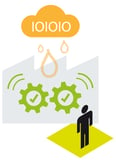Can Digitization Eliminate Planning Silos?
Nick Ostdick - December 14, 2017

 The title of this blog says it all. Planning silos, even in today’s fairly integrated, optimized supply stream, are still a major challenge for manufacturing companies, especially in variant-rich industries with complex partner-networks. The prospect of cross-organizational communication and data-sharing in the planning stage of the production cycle remains for too many companies simply that: A prospect, a goal, rather than a standard mode of operation.
The title of this blog says it all. Planning silos, even in today’s fairly integrated, optimized supply stream, are still a major challenge for manufacturing companies, especially in variant-rich industries with complex partner-networks. The prospect of cross-organizational communication and data-sharing in the planning stage of the production cycle remains for too many companies simply that: A prospect, a goal, rather than a standard mode of operation.
But for manufacturing companies who understand and realize its value, digitization can be a critical (or perhaps the critical) tool in eliminating these planning silos and fostering an atmosphere of communication and collaboration during the production planning process. Whether it’s constructing a more efficient, streamlined planning and production scheme or creating enhanced methods of procurement, inventory management, job allocation, and transport logistics, digitization is a supply chain management platform whereby companies can leverage greater efficacy to grow their business, create stronger partner networks, and leverage competitive advantages in an increasingly crowded marketplace.
Because digitization centers on decentralizing data hubs and creating a more collaborative environment between the planning and production stages of the manufacturing cycle, traditional planning silos can be eliminated in favor of fostering stronger links from the C suite to the production floor — a philosophy that’s becoming increasingly valuable in modern supply chain management. Today’s integrated supply chain can no longer operate on the concept that the various stages in the manufacturing cycle function in disparate fashion. As such, digitization can be a truly disruptive force in pushing manufacturing companies to unite these various stages and create a coordinated environment where these stages work in conjunction for greater efficiency and productivity.
The problem with planning silos
The sheer concept of a silo — a top down entity with little room for maneuverability — is problematic for the variant-rich automotive industry. Demand planning is not a one-direction-only process where planners and managers move from start to finish throughout the planning process. Instead, given the constantly shifting rules and constraints of production programs, planners must be able to alter plans, modify production programs, reallocate part or part families, and monitor variables on the production floor in real-time to ensure orders are filled and delivered on-time.
As such, planning silos create a number of troubling barriers to effective production planning, including:
Align sales, procurement, inventory, and production into one cohesive process. Because sequential planning silos isolate different processes that are key in overall demand planning strategy, various departments within a manufacturer's architecture lack the ability to communicate and share vital information about sales, procurement, inventory, job allocation, and transportation. This lack of transparency can not only significantly reduce a manufacturer’s efficiency and productivity, but it can also result in bottlenecks and breakdowns at various points across the value chain.
Modify production programs in real-time. In a variant rich industry where production variables and constraints can change while jobs are being processed on the production floor, the ability to modify production programs in real-time do not only increase efficiency and cost-effective production models, but also ensure the production stage is not disrupted by slowdowns stemming from outdated or irrelevant planning strategies. A siloed planning platform prevents this level of communication and collaboration and encourages ineffective job and resource allocation.
Gain valuable insight into the impact of each component stage. Today’s integrated automotive supply chain is no longer a disparate set of processes where little communication or data sharing takes place between departments or organizations. To optimize planning and production efficiency, various stages of the sales and planning process must coordinate on goals and objectives. By breaking down planning silos, planners and managers can gain valuable insights into the impact of each component stage on others to increase productivity and efficiency.
How digitization breaks down planning silos
With the difficulties of planning silos more clearly defined, the question becomes: How does digitization actually break down these silos and open lanes of communication, data-sharing, and collaboration across the major players in the production planning sequence? Because digitization demands not only an integration of intelligent planning and production solutions (BOM management, PFEP, and transport logistics) but also an reengineering of traditional supply and production models, digitization reduces the occurrence of planning silos through such key actions as:
Increased supply chain visibility: We know the value of end-to-end (E2E) visibility in today’s automotive supply chain and the importance in engineering this visibility for greater production efficiency. Breaking down planning silos and discovering areas where planners and managers can create a more coordinated planning structure and architecture is key in enhancing visibility into a manufacturer’s overall supply situation.
Enhanced agility: Agility and responsiveness are two prized traits in a global industry where constraints and variables are constantly shifting and altering. Planning silos are a significant stumbling block in manufacturing companies achieving the lean, agile planning and production models necessary to adapt to real-time alterations in production programs. Breaking down planning silos and addressing various planning stages as a holistic enterprise will help manufacturing companies operate with greater maneuverability and agility.
An emphasis on transparency: If visibility into a manufacturing company’s overall supply situation is a core driver of optimized production, then greater transparency into how a company’s supply chain function is the way in which planners and managers achieve greater visibility. Breaking down planning silos provides companies with critical insight into how their planning and production function in coordination with each other, as well as exposing areas where efficiencies can be increased to further optimize production.
LATEST POSTS
- Understand Why Production Planning Needs Specialized Solutions
- Understand Circular Economy in The Manufacturing Industry
- How Can Industry 4.0 IT Integration Be Achieved Smoothly?
- The Significance of Order Sequencing in Discrete Manufacturing
- How to improve your Supply Chain Management: The Power of Control Towers



